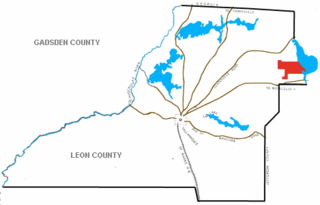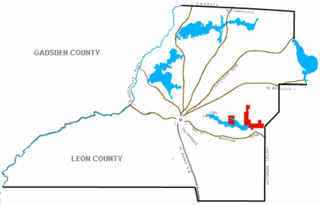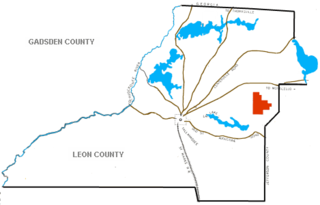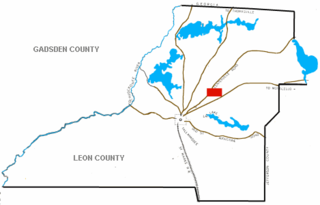
Burgesstown Plantation was a large cotton plantation of 8,100 acres (3,300 ha) in northern Leon County, Florida, United States established by Frederich R. Cotten between 1850 and 1855.

The James A. Kirksey Plantation was a moderate plantation of 2,600 acres (1,100 ha) located in northwestern Leon County, Florida, United States, established by James A. Kirksey. In 1847 he served as mayor of Tallahassee. He had a large number of slaves.

The William G. Ponder Plantation was a large cotton plantation of over 5,756 acres (2,329 ha) situated in northeastern Leon County, Florida, United States and established by William G. Ponder.

Blakely was a small cotton plantation of 900 acres (360 ha) located in extreme northeast Leon County, Florida which was established by Miles Blake.

Chemonie Plantation was a medium-sized cotton plantation of 1,840 acres (740 ha) in northern Leon County, Florida, United States established by Hector Braden.

La Grange Plantation was a large cotton plantation of 4,150 acres (1,680 ha) located in central Leon County, Florida, United States established by Joseph John Williams.

Evergreen Hills Plantation was a large cotton plantation of 6700 acres (27 km²) located in eastern Leon County, Florida, United States established by Green A. Chaires.

Tuscawilla Plantation was a large cotton plantation of 3,000 acres (1,200 ha) located in eastern Leon County, Florida, United States established by George W. Parkhill.
Verdura Plantation was a large cotton plantation of 3,500 acres (1,400 ha) in eastern Leon County, Florida, United States established by Benjamin Chaires, Sr.
Woodlawn Plantation was a large plantation located in eastern Leon County, Florida, U.S., owned by Thomas Peter Chaires.

Joseph Chaires Plantation was a large cotton plantation of 3,800 acres (1,500 ha) located in southern Leon County, Florida, United States owned by Joseph Chaires.

The House Place Plantation was a small cotton plantation of 1,800 acres (730 ha) located in central Leon County, Florida, United States established by R.A. Whitfield.

Walnut Hill Plantation was a small cotton plantation of 2,120 acres (860 ha) located in northern Leon County, Florida, United States owned by Thomas Anderson Bradford.

The Francis Eppes Plantation was a small cotton plantation of 1920 acres (8 km2) situated in east-central Leon County, Florida, United States and established by Francis W. Eppes in 1829.

The R. G. Shepard Plantation was a small cotton plantation of 1,400 acres (570 ha) located in south central Leon County, Florida, United States established by R.G. Shepard.

Ingleside Plantation was a medium sized cotton plantation of 2,620 acres (1,060 ha) located in extreme northeast Leon County, Florida and established by Joel C. Blake.

Orchard Pond Plantation was a large cotton plantation originally of 8754 acres, (35½ km2) developed and owned in the 19th century by Richard Keith Call, attorney, planter and future Territorial Governor, in what is now northwestern Leon County, Florida, United States. In 1860 he owned 118 slaves to work the 1300 acres of improved land.
Miccosukee Plantation was a medium-sized cotton plantation of 2517 acres (10 km2) located in eastern Leon County, Florida. It was developed by John Miller, from Duplin County, North Carolina, who had migrated south during the period of Indian Removal in the 1830s. He depended on the labor of enslaved African Americans to develop the plantation and produce cotton as a commodity crop.

Barrow Hill Plantation was a large cotton plantation of 3,990 acres (1,610 ha) located in central Leon County, Florida, United States. It was established by John S. Winthrop.
The Robert W. Williams Plantation was a small cotton plantation located in of approximately 800 acres (320 ha) located in northern Leon County, Florida, U.S. established by Robert W. Williams.

















